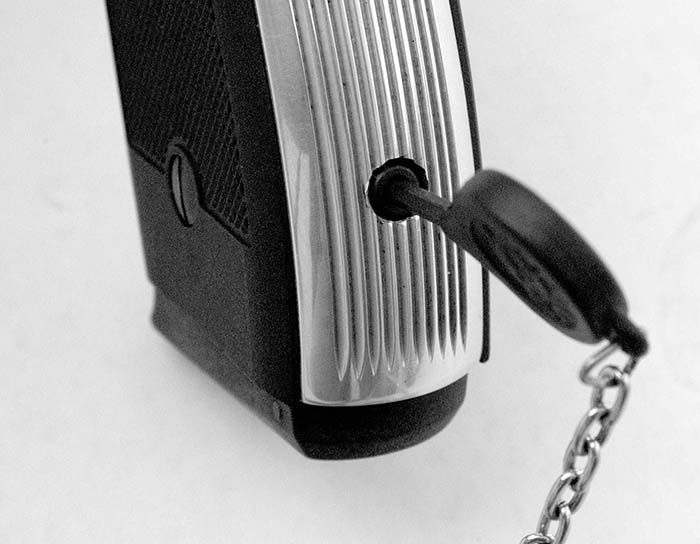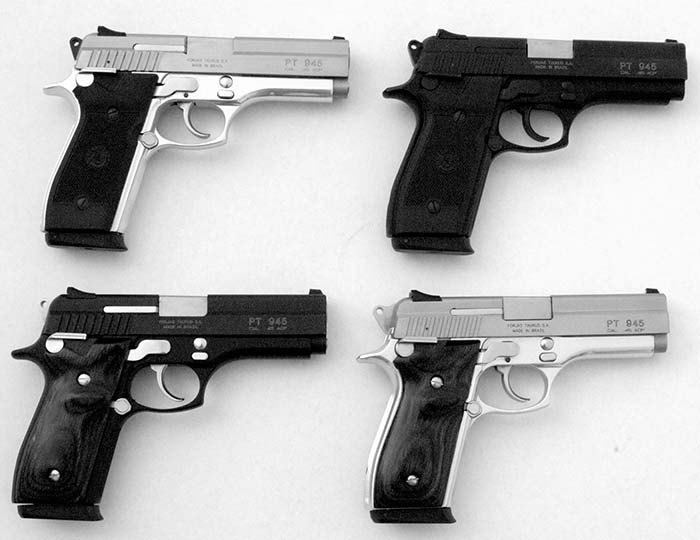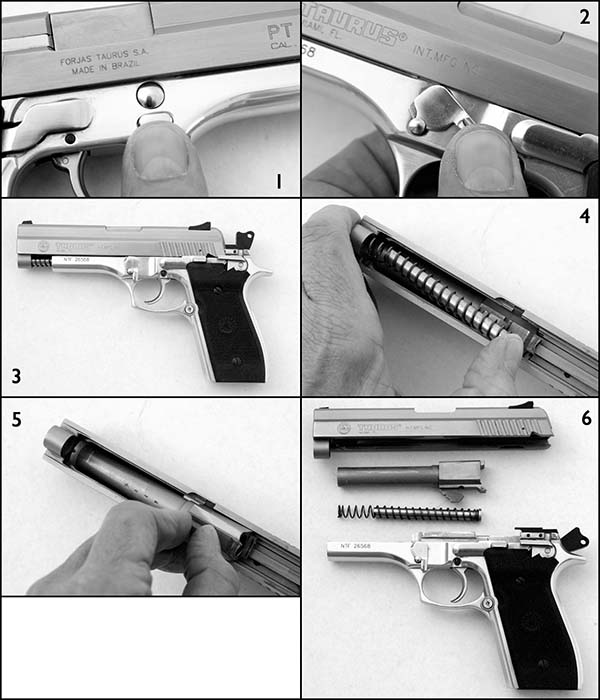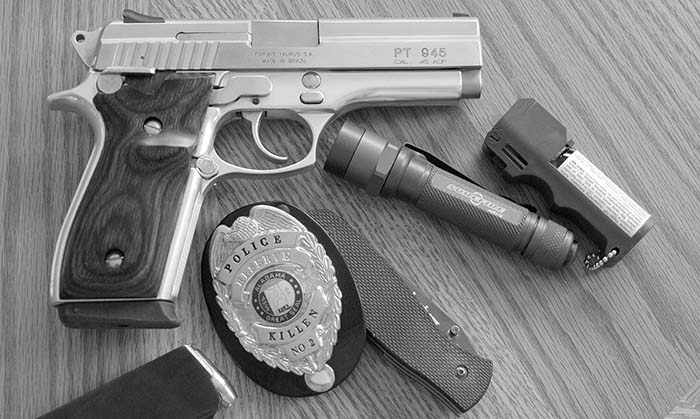Taurus PT945 is suitable for off-duty police use or for concealed carry.
by Charlie Cutshaw
The 97-year-old .45 Automatic Colt Pistol (ACP) cartridge refuses to die, despite having been pronounced moribund on a number of occasions, most recently when the US Military adopted the caliber 9x19mm M9 pistol. After briefly experimenting with the M9 and other 9x19mm pistols, most American special operations organizations returned to the .45 ACP. Marine Corps special operations capable expeditionary units continue to use modified M1911A1 pistols, designating them MEU-SOC (Marine Corps Expeditionary Unit – Special Operations Capable) Pistols. Then there is Heckler & Koch’s .45 ACP Mk 23 SOCOM handgun, designed specifically for special operations use. Most recently, the 9x19mm has proven to be less than satisfactory in combat in Afghanistan, where there has reportedly been a clamor for resurrecting M1911A1s or at least a .45 ACP handgun that is an effective “people stopper.”
When one thinks of a .45 ACP pistol, the venerable M1911/M1911A1 usually comes to mind. It remains a viable handgun for military, law enforcement or personal defense use. In its “commander”-size, the pistol is more adaptable to concealed carry. One problem with most standard M1911 type pistols, whatever their size, is the fact that they are not fully reliable with all types of ammunition, especially some jacketed hollow point (JHP) cartridges. The price of entry for a quality M1911 is typically quite high – usually over $1,000 for a pistol with a crisp trigger, reliable feeding and enhanced accuracy. There is, however, a very reasonably priced alternative to an expensive custom “commander”-sized M1911 – the Taurus PT945.

Taurus pistols are made in Brazil on computer numerical controlled (CNC) machinery and thus maintain a high degree of consistent tolerances and quality of manufacture. Lest the reader mistakenly believe that Brazilian manufacture is somehow of lesser quality than “Made-in-USA” firearms, the fact is that several “name” manufacturers of high quality firearms import their components from Brazil and assemble them here. The PT-945 combines the best from Taurus’ 9mm PT-92 series, along with some desirable features from the M1911. The combination is a Commander-sized “single stack” .45 ACP pistol that is worth a look by anyone desiring a reliable, high quality .45 ACP pistol. A comparison between the PT945 and Commander reveals that the two are virtually identical in every dimension. The silhouettes of the two pistols are likewise almost the same. The PT945 mimics the Commander in almost every tactile aspect. Controls are placed similarly to the M1911, but improved in size and shape.
The PT-945’s frame is alloy, with a double-action/single-action fire control mechanism. The frame-mounted safety lever has three positions. “Up” is safe and the pistol can be carried “cocked and locked” in Condition One. The middle position is “fire.” Pressing the lever fully down safely drops the hammer. I personally use a matte stainless PT945 for IDPA and concealed carry, and unlike many factory M1911A1 pistols, it reliably feeds every type of ammunition I have ever run through it, including semiwadcutter, which rarely will feed reliably through a stock M1911A1, except very expensive custom pistols that come from the factory “ramped and throated.” The Taurus’ trigger pull in the double-action mode is long, but smooth, and at an average of 9.5 to 10.5 pounds in the pistols tested, not overly heavy. Despite this, when one fires the first shot in double-action and then must switch to single action, the trigger’s position and pull weight are changed, and the firing grip must be altered somewhat, affecting accuracy and speed of the following shot. For this reason, I carry my PT945 just as I carry a M1911A1 – Condition One, “cocked and locked.” The manual of arms in this mode is identical to that of the M1911A1, so there are no changes. The PT945’s single-action trigger is two-stage with a crisp “break,” no discernable creep and a small amount of overtravel. Single-action trigger pull of the PT945s tested for this article averaged 4.5 to 5.5 pounds, which is pretty close to ideal for a combat handgun.

As to overall “feel,” the Taurus engineers mimicked that of the M1911A1 to the greatest extent possible. The PT945 grip-to-frame angle is identical to the M1911A1, but there is no grip safety. Both the front and back grip straps are serrated along their entire length for enhanced grip. The PT945’s butt is rounded, which makes it less likely to “print” when being carried concealed. The magazine-well is beveled to facilitate reloading. Controls such as safety, slide release and magazine release are positioned in essentially the same location as those of the M1911A1. The safety is ambidextrous, but doesn’t “bite” the knuckle of the trigger finger like some M1911 ambidextrous safeties. Again, if one is familiar with the M1911, there is nothing new to learn. The M1911 shooter can pick up a Taurus PT945 and head to the range knowing that the manual of arms for his new pistol is identical to his old favorite. The PT945 sits relatively low in the hand, and points in an almost identical manner as any M1911A1 variant. The PT945’s backstrap contour is slightly different than the M1911 or M1911A1, but this did not affect accuracy or the pistol’s natural pointing capabilities.
The PT945 slide is steel and has no barrel bushing. The extractor also serves as a loaded chamber indicator; when a round is chambered, it protrudes slightly revealing a small red notch and stands just above the slide’s surface to provide a tactile indication. This doesn’t eliminate the need to physically clear the pistol in accordance with good gun-handling practice, but it does provide an instant indication. Sights are combat-type with a square-notch rear sight with small white dots and a blade-type front sight with a larger single white dot. Trijicon(tm) tritium sights are available as an option.
The PT945 is unique in the variety of finishes available. Many pistol makers offer various finishes, but Taurus’ variety exceeds that of any other manufacturer. PT945s are available from “plain vanilla” blue with rubber grips to “fancy” in either blue or polished stainless with gold-plated controls and rosewood or mother of pearl grips. While some may denigrate fancy grips and gold plating, we should recall that no less an American hero than George S. Patton, Jr. carried fancy pistols, as have many other very serious and deadly handgunners. My personal carry/IDPA PT945 is stainless with hard rubber grips.

Besides the special finishes, which are esthetic enhancements, Taurus also offers functional options, one being barrel porting. This option reduces felt recoil and muzzle flip, but if one plans to use their PT945 in IDPA competition, it must be noted that ported barrels are forbidden. Also, I find cleaning the inside of the ported barrel PT945’s slide is a real chore.
The PT945’s method of operation is the Browning short recoil system with the barrel’s locking block engaging the ejection port. This system improves the basic Browning system by reducing the number of engagement surfaces. The very large ejection port extends halfway down the right side of the slide and wraps over the top left of the slide. There is no barrel link, but a cam lug similar to that of the Browning M1935 on the bottom of the barrel forces it into and out of battery. The slide locks to the rear after the final shot and the magazines drop free when the release if pressed.
I stated earlier that the PT945 is more reliable “out-of-the-box” than any standard grade M1911A1 I have experienced. As mentioned, I have been unable to find a .45 ACP cartridge that would not cycle through any of the PT945s tested for this article. This is attributable to the polished feed ramp that is actually machined into the barrel. When the barrel moves slightly to the rear and drops down after the spent case is ejected, the ramp is positioned into a notch in the frame. At the same time, the magazine positions the next cartridge high on the feed ramp, almost in a direct line with the chamber. This is a decided improvement over the M1911A1, in which the round first hits the feed ramp in the frame, and then bounces up into the chamber. The next M1911 critical point is the chamber throat, which also should be polished to ensure reliable feeding. After the cartridge bounces off the frame’s feed ramp, it caroms up into chamber throat, where the nose impacts it at an angle. If the throat is unpolished, the cartridge may again come to a full stop, causing a severe stoppage. Most high quality 1911-type handguns today have taken steps to eliminate this problem, but the potential is still there, and the author has experienced it in several current standard-grade production pistols
I found the PT945 to point naturally and to be easy to control, even with +P ammunition. At an overall average of 2.9 inches at 15 yards, accuracy for the eight pistols tested was about what one would expect from a stock .45 ACP pistol. Since the test results for all pistols would create a very busy chart, I have reduced the accuracy to averages for each type of ammunition fired. Accuracy results can be found at Table 1. Aside from the variety of pistols available, Taurus has two additional features that they pioneered. One is the Taurus Security System(tm). Taurus’ system is integral to the pistol and requires no external locks, cables or other equipment, except a key. The second unique Taurus feature is the company’s Unlimited Lifetime Repair Policy(tm). If a Taurus pistol ever breaks for any reason due to a manufacturing defect, the company will repair it at no cost. This warranty is transferable from one owner to another without registration, but does not include sights, accessories, cosmetic defects after one year, or damage caused by customer abuse, such as high-pressure reloads.
The sole complaint I have regarding the PT945, or for that matter, any Taurus pistol is that there is only a single magazine included in the purchase price. I believe that any pistol that might be used for self-defense should be provided with at least one spare magazine.
PT945 takedown is actually simpler than a M1911 type pistol. Clear the pistol and remove the magazine. Move the slide forward into battery. Press in on the locking button on the right side of the slide and rotate the takedown lever clockwise. (The takedown lever will not rotate with the slide to the rear.) It will automatically lock into the down (disengaged) position and the slide will move slightly forward on the frame. The slide can then be removed from the frame by pulling it forward. Lay the slide upside down on a table or bench. Press forward on the full-length recoil spring guide rod and separate it upwards and to the rear from the slide assembly. Lift the barrel out of the slide. This completes field stripping and no further disassembly is necessary or recommended. Reassembly is generally the reverse of disassembly, except when the slide is mated to the frame, the takedown lever will automatically snap back into the locked position. Move the slide back and forth a few times to confirm that the slide is locked to the frame.

To sum up, Taurus’ PT945 offers a lot for the price. Suggested retail runs from $560 to $655, depending on options. The PT945 offers a reliable, quality pistol for competition or self defense at a very competitive price.
If there is any downside to the PT945 or any other Taurus pistol, it is the lack of carry gear for it. Holsters intended for other pistols can be used with Taurus products, but they generally do not fit well, and few manufacturers offer custom-made holsters for Taurus pistols. This is about to change, however. A small specialist company, Ready Tactical Products of Decatur, Alabama has begun manufacture of holsters and magazine carriers for all Taurus pistols. The holsters are made of high grade Kydex and are of extremely high quality, but are priced very competitively. All Ready Tactical holsters are adjustable for tension. In addition, Ready Tactical offers its very innovative “Claw”® magazine carriers that positively retain magazines without the use of snaps or flaps.
Sources:
Taurus International Manufacturing, Inc.
16175 NW 49th Avenue
Miami, FL 33014
Tel: (305) 624-1115
Fax: (305) 623-7506
www.taurususa.com
Black Hills Ammunition
PO Box 3090
Rapid City, SD 57709-3090
Tel: (605) 348-5150
Fax: (605) 348-9827
E-mail: bhammo@rapidnet.net
International Cartridge Corporation
RR#2, Box 300
Reynoldsville, PA 15851
Tel: (814) 653 0390
Fax: (814) 938-6821
www.internationalcartridge.com
Remington Arms Company
870 Remington Dr.
Madison, NC 27025
Tel: (800) 243-9700
Fax: (336) 548-7801
www.remington.com
Ready Tactical Products
1604 Saginaw Lane, SW
Decatur, AL 35603
Tel: (256) 350-4247
Email: const@swbell.net
Trijicon, Inc
49385 Shafer Ave.
PO Box 930059
Wixom, MI 48393
Tel: (248) 960-7700
Fax: (248) 960-7725
www.trijicon-inc.com
| This article first appeared in Small Arms Review V7N9 (June 2004) |











